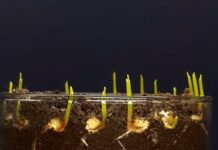
Organic herbs farming is one of the oldest known sustainable agricultural practices.
Organic herbs farming is basically done without the use of chemical fertilizers or synthetic pesticides on unpolluted land, by natural means, and by adding organic material.
According to WHO(World Health Organization), close to 80% of Asian and African countries depend on traditional herbs for primary health care. Consumer from these countries focuses on economical and safer herbal medicine systems as well.
Organic herbs farming methods aim at minimizing the human impact on the environment and ensuring the agricultural system works as naturally as possible.
Organic farmers are able to produce plants with great quality, taste, and authenticity, fundamental for the health and wellbeing of people.
Many of the techniques used in organic farming include intercropping, mulching and integration of crops and livestock. Correctly managed organic herb farming eliminates or at least reduces water pollution and aids in conserving water and soil.
Organic herbs are usually grown for extracting herbal oils and producing herbal products. It can be used for medicinal purposes as well.
Before we get into the details of organic herb farming process, let’s look at the outline of the process. We start with a selection of herbs first. Depending on the type of herb, we prepare the land, then select the seed, followed by sowing the seed, irrigation, waiting for the herbs to grow and finally harvesting.
While there are plenty of herbs to list out, some of the most widely grown herbs are:
- Basil
- Bay Leaves
- Cilantro Leaves
- Celery Flakes
- Curry Leaves
- Dill Weed
- Dried Chives
- Dried Fenugreek Leaves
- Dried Rose Petals
- Kaffir Lime
- Lavender
- Lemongrass
- Marjoram
- Mint
- Oregano
- Parsley
- Rosemary
- Sage
- Thyme
Following are the detailed guidelines to organic herb farming:
Research. Market Demand. Selection of Herb. Budget.
Different herbs come with different price tags. Doing a bit of research on the sale potential and market demand of the herb would help. It would enlarge your understanding of what is happening in the market. In addition, you’ll get to know the demand and supply of that particular herb in the market. Check on the budget required for the cultivation of each herb. Work out a plan on how you are going
to apportion the budget for the entire farming process. Check if the herb is feasible with the quality of land and climate. If it doesn’t work, then figure out the alternatives.
Land. Layout. Fertility.
The first step would be to verify the effects of the previous cultivation and to see how to minimize the impact if there were any signs of disease. Then bring the land to its normal fertility with the help of organic fertilizers. Plan out the layout of the field with respect to the type of herb for efficient irrigation. Check for the latest techniques for leveling the fields.
Selection of Seed.
This is the most essential part of herb farming process. Thorough research would be required to check on the price and quality of herbs. Calculation of average quantity needed per acre, water requirement, suitability of area and climate factoring herb growth; and an estimate of how much is sown as against average yield ratio would be some recommended actions to do in the process of seed selection.
Sowing the Seed. Irrigation.
It is advisable to note the appropriate time/season to sow the herbal seed. Check for weather conditions at the time of sowing. Research on the methods for sowing the herbal seeds. Choose the best suitable method for sowing.
Plan on your time for herbal irrigation. It is very vital to study the time and frequency of irrigation. Unless we have the application of what amounts of water go to plants at appropriate intervals, it would be a challenge to grow herbs as how it should be.
Monitor the growth of herbs
There are many factors that key when it comes to monitoring the growth of herbs. It is necessary to analyze the average growth rate of the herb in normal conditions. Check what kind of interventions are needed to maintain estimated growth. Have a consistent comparison of the growth rate of herbs, its crop color, leaf size, according to the given conditions and input.
While supervising the growth of organic herbs, it is also essential to watch out for virus or pest attacks, observe the symptoms of such attacks, and take precautionary measures to avoid virus/pest attacks in advance.
Harvesting
Note down the proper time and method for harvesting. Keep yourself updated with market rates on the organic herbs. Ensure to get properly-secured herb storage in place. Plan up to the transportation of herbs.
What do you do after harvesting?
When you are ready with the harvest, the parallel strategy would be to identify the target audience and the key markets to sell your produce. So, do the necessary homework to get leads.
The target audience could be your local organic herbs manufacturers, e-commerce companies, raw material suppliers, traders, retailers and wholesalers, importers and exporters.
The demand and supply of organic herbs may vary based on several conditions including consumer awareness, knowledge of side effects, aging population, intensifying prices, restricted health budgets of the medicinal system and so on. Key players in the global herbal medicine market include India, Germany, Spain, France, Australia, Taiwan, Switzerland, and the U.S, among others.
Likewise, your market knowledge on these aspects would be of prime help.
Organic herbs have shown no sign of slowing down. While organic herbs have gained immense popularity, conventional herbs remain popular as well. But the organic products are preferred still.
We hope this information on organic herbs farming was of benefit to you.






